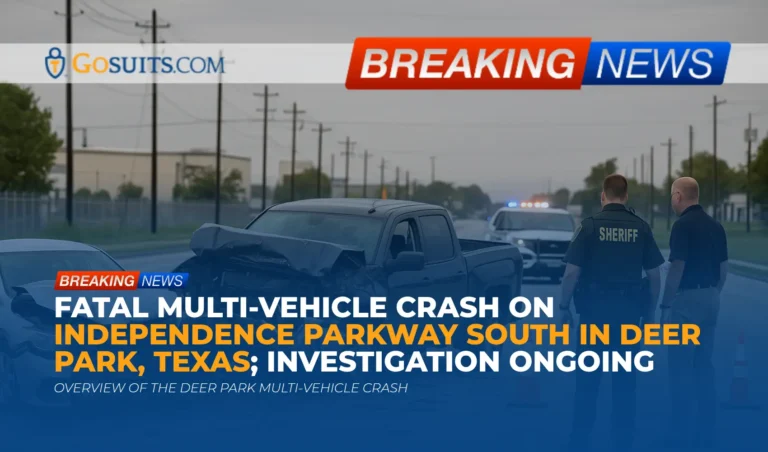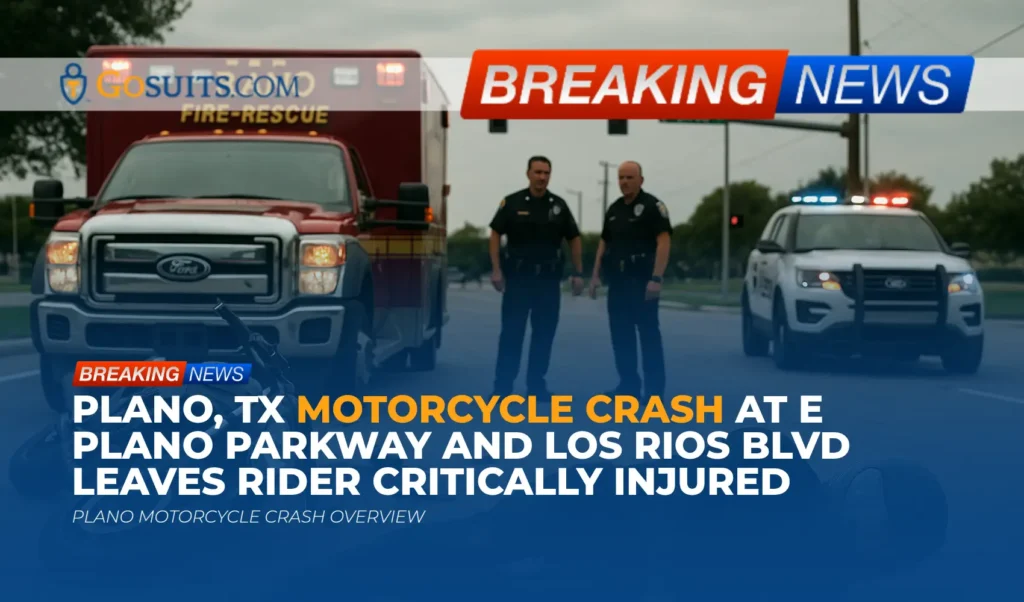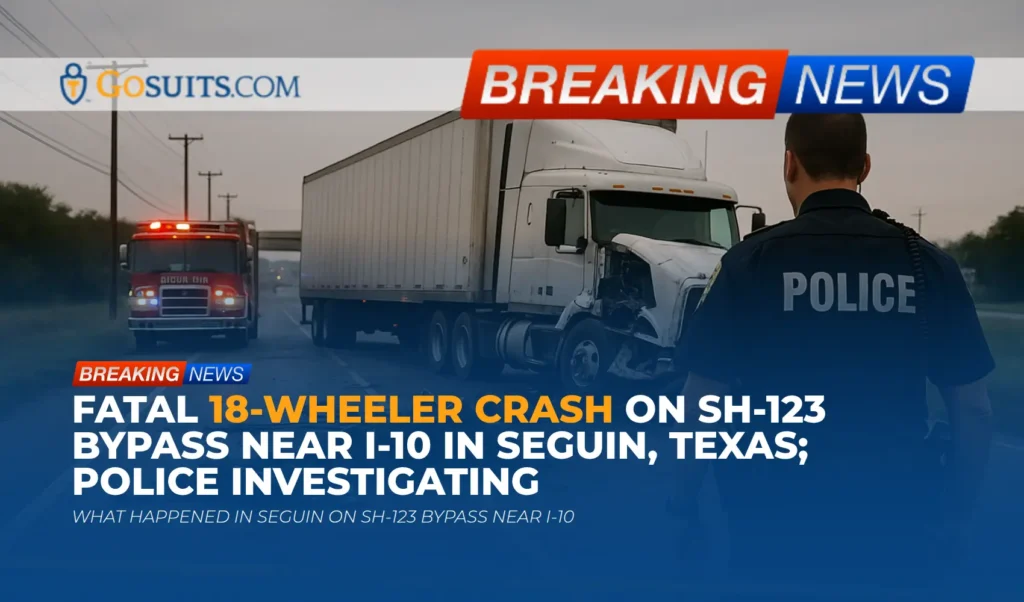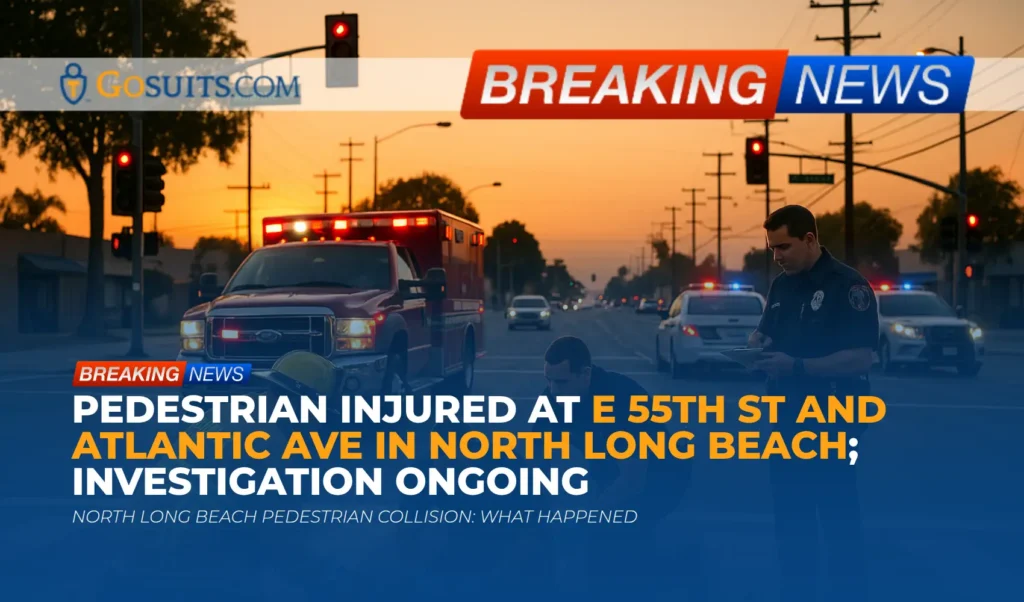- Overview of the Deer Park multi-vehicle crash
- What is known so far
- Location, roadway conditions, and traffic impacts
- Agencies likely involved and how investigations typically proceed
- How to obtain official records: crash report, autopsy report, and death certificate
- Texas civil remedies after a fatal crash
- Potential civil liability in a multi-vehicle collision
- Key evidence families may want preserved
- Insurance issues and early claim considerations
- Wrongful death and survival damages in Texas
- Time limits that can affect civil claims
- Safety context and community considerations
- Practical next steps checklist
- Why timely action matters
- Commentary from Gosuits Deer Park, Texas Personal Injury Attorney
Overview of the Deer Park multi-vehicle crash
A fatal multi-vehicle collision occurred on a Wednesday morning in Deer Park, Harris County, on the 1900 block of Independence Parkway South. According to information released by the Harris County Sheriff’s Office and sheriff leadership on scene, at least two vehicles sustained heavy damage and one person tragically lost their life. Authorities diverted traffic coming from Highway 225 and traffic approaching from the ferry area while they conducted the on-scene investigation and cleared the roadway. The cause of the crash had not been publicly determined at the time of reporting, and the investigation remains ongoing.
We extend our sincere condolences to those affected. The information below is intended to help families understand what typically happens after a fatal roadway incident in Harris County, where vital records can be obtained, and what civil law issues may matter in the weeks ahead.
What is known so far
Core facts reported by authorities
– Multi-vehicle collision on the 1900 block of Independence Parkway South, Deer Park, Harris County.
– Occurred on a Wednesday morning, with one confirmed fatality.
– At least two vehicles were heavily damaged.
– The Harris County Sheriff’s Office is investigating; the precise cause has not yet been announced.
– Traffic from Highway 225 and from the ferry area was redirected, and drivers experienced delays near the scene.
When final determinations are made, they typically address contributing factors such as vehicle movements, traffic controls, speed, impairment, visibility, weather, and roadway design or maintenance conditions. Families usually receive updates as reports are completed and released under Texas law.
Location, roadway conditions, and traffic impacts
Independence Parkway South serves industrial and commuter traffic in eastern Harris County, with connections to Highway 225 and nearby ferry traffic. When crashes occur on or near arterial corridors that link to a highway or ferry, congestion and secondary risks can grow rapidly. In response, law enforcement commonly closes lanes or reroutes vehicles to protect the scene, preserve evidence, and allow emergency responders to work safely.
If lane closures or detours persist beyond the immediate response, transportation agencies sometimes publish updates to inform the public. Travelers are encouraged to follow official county and state updates and to use caution when approaching any active investigation area.
Agencies likely involved and how investigations typically proceed
– Harris County Sheriff’s Office: Oversees the on-scene investigation for many serious crashes in unincorporated areas and collaborates with other local agencies when incidents occur within a city’s boundaries. Specialized units are often tasked with collision reconstruction, evidence collection, and interviewing witnesses.
– Medical Examiner: In Harris County, the Harris County Institute of Forensic Sciences conducts medicolegal death investigations. The office determines cause and manner of death, performs autopsies when indicated, and maintains records that next of kin can request. See the county’s medical examiner home page at ifs.harriscountytx.gov.
– Texas Department of Transportation (TxDOT): TxDOT maintains the state crash records database and, under Texas law, certain crash reports can be made available to parties authorized by statute. The release of crash reports is governed by Texas Transportation Code § 550.065.
Crash investigations can take weeks as investigators review scene measurements, photographs, vehicle condition, electronic data, and witness accounts. If commercial vehicles are involved, additional federal and state regulations may affect the scope of the investigation and the records preserved.
How to obtain official records: crash report, autopsy report, and death certificate
Texas crash report access
Texas Transportation Code § 550.065 governs who may obtain a crash report and how it may be released. Typically, an involved driver, an authorized representative, or a legal next of kin may request the report. The report usually includes basic crash details, parties involved, contributing factors identified by the investigating officer, and diagramming if provided.
Many families and insurers rely on the crash report to begin claims handling. However, crash reports may be updated or supplemented if new information emerges, and they often do not include all of the technical analysis that might appear later in reconstruction findings.
Autopsy report and cause of death
In Harris County, the Harris County Institute of Forensic Sciences provides autopsy and postmortem examination reports to authorized requestors. Families can find information about the office and how to request reports at ifs.harriscountytx.gov. These records can be important for life insurance claims, benefits, probate matters, and civil claims.
Death certificate
A certified death certificate is generally required for many administrative steps following a loss. In Texas, guidance on ordering death certificates is available through the Texas Department of State Health Services at dshs.texas.gov/vital-records/death-certificates. Funeral homes often assist families with the initial orders.
Texas civil remedies after a fatal crash
Texas law provides civil remedies that may be available after a fatal roadway incident. Two types of claims are commonly discussed: wrongful death and survival actions. These remedies are distinct, and each serves a different purpose.

Wrongful death claims
The Texas Wrongful Death Act allows certain family members to seek civil recovery when a death is caused by the wrongful act, neglect, carelessness, unskillfulness, or default of another. See Texas Civil Practice and Remedies Code Chapter 71.
Who may bring the claim is addressed in § 71.004, which identifies eligible beneficiaries, typically including the decedent’s spouse, children, and parents. These claims are brought for the losses suffered by the eligible family members themselves.
Survival actions
A survival action continues the decedent’s own claim that arose before death, allowing the estate to seek damages that the decedent could have pursued had they survived. See § 71.021. Survival claims are brought by the legal representative of the estate, and any recovery passes to the heirs or beneficiaries through the estate process.
Potential civil liability in a multi-vehicle collision
In multi-vehicle crashes, fault may be shared among multiple drivers or entities. Civil responsibility is determined under Texas’s proportionate responsibility rules. A trier of fact may assign percentages of responsibility to each party whose conduct contributed to the harm. Texas Civil Practice and Remedies Code Chapter 33 explains the comparative responsibility framework often applied in these cases.
Important considerations may include:
- Right-of-way and traffic control compliance: Whether drivers obeyed signals, signs, and lane controls.
- Speed and following distance: Whether a driver’s speed or tailgating contributed to the inability to stop or avoid a collision.
- Attention and distraction: Whether a driver was distracted or failed to keep a proper lookout.
- Vehicle condition: Whether mechanical issues such as tire, brake, or lighting defects played a role.
- Roadway and environmental factors: Visibility, lighting, construction zones, or roadway hazards that may affect responsibility.
- Commercial vehicle compliance: If any vehicle was operating commercially, applicable safety regulations and maintenance records may be relevant.
While law enforcement findings can be influential, civil responsibility in a lawsuit or claim may also account for additional evidence developed after the initial report, including expert reconstruction, electronic data, and third-party witnesses or footage.
Key evidence families may want preserved
Preserving evidence early can clarify what happened and protect the integrity of a civil claim. Consider the following categories:
- Vehicle preservation: Ensuring involved vehicles are not destroyed before they can be inspected for crash damage patterns, airbag module data, and mechanical condition.
- Electronic data: Event data recorder downloads, infotainment system logs, commercial vehicle telematics, and any GPS or fleet data.
- Scene documentation: Photographs, debris field mapping, skid or yaw marks, roadway measurements, and traffic control locations.
- Video sources: Fixed cameras near industrial sites, business exteriors, traffic cameras, or residential doorbell devices along travel routes.
- Witness information: Names, contact details, and statements from independent witnesses, especially commuters or nearby workers.
- Medical and forensic records: EMS run sheets, hospital records, autopsy findings, and toxicology reports obtained through authorized channels.
- Cell phone records: In appropriate circumstances and with proper legal process, phone records may help assess distraction issues.
Timely written preservation requests to potential at-fault parties, fleet owners, or insurers can help safeguard important materials. Responses and retention policies vary, so documenting the request and any replies is helpful.
Insurance issues and early claim considerations
Insurance coverage often determines the practical path to recovery. Texas requires drivers to maintain minimum financial responsibility coverage described in Texas Transportation Code § 601.072 (commonly referred to as 30/60/25 for bodily injury and property damage minimums). In fatality cases, minimum limits may be insufficient, so identifying all potential coverages is important.
Coverage avenues that may come into play:
- At-fault driver liability policies: Primary coverage for harms caused by a negligent driver.
- Employer or commercial policies: If a vehicle was being used for work or was a commercial unit, higher policy limits or multiple layers may exist.
- Uninsured/Underinsured Motorist (UM/UIM): A family’s own auto policy may provide UM/UIM benefits when at-fault coverage is unavailable or inadequate.
- Medical payments or Personal Injury Protection (PIP): First-party coverage that may assist with certain immediate costs, subject to the policy terms.
- Umbrella or excess policies: Personal or corporate umbrella policies can extend available limits.
Early contact with insurance companies is common, but statements can impact later proceedings. Before giving recorded statements or signing authorizations, it is prudent to consult with a qualified attorney. What is said to an insurance carrier may be used to minimize or deny claims later. Independent documentation, careful record-keeping, and measured communication can prevent misunderstandings.
Wrongful death and survival damages in Texas
The law distinguishes between losses suffered by surviving family members and losses that belonged to the decedent and pass through the estate. While every case is unique, the following are categories often evaluated, subject to proof and applicable statutes:
- Pecuniary losses: The financial contributions, services, care, support, maintenance, and advice the decedent would have provided to the eligible beneficiaries. See Chapter 71.
- Mental anguish and loss of companionship: Intangible harms suffered by eligible family members under the wrongful death statute.
- Funeral and burial expenses: Often recoverable in either wrongful death or survival contexts, depending on who incurred the expense.
- Medical expenses before death: In a survival action, the estate may seek medical expenses and other losses incurred by the decedent before passing. See § 71.021.
- Pain and suffering of the decedent before death: Potentially recoverable in a survival action if supported by the evidence.
Punitive damages are treated differently and require proof of certain aggravated conduct, which is fact-specific and controlled by statute and case law. Families often benefit from a careful evaluation of the evidence to understand which damages are supported.
Time limits that can affect civil claims
Civil claims must be filed within defined deadlines under Texas law. For wrongful death and survival actions, Texas Civil Practice and Remedies Code § 16.003 generally provides a two-year limitations period, subject to limited exceptions. Time can pass quickly during investigations and probate proceedings, so documenting dates and preserving evidence early can be critical to protecting rights within the applicable time frames.
Safety context and community considerations
A fatal multi-vehicle crash on a major corridor reverberates through the community, affecting families, co-workers, first responders, and nearby businesses. While the cause here remains under investigation, roadway safety is a shared responsibility among drivers, fleet operators, and maintainers of the transportation system. Common-sense safety reminders that often reduce risk include maintaining safe following distances, adjusting speed to conditions, avoiding distraction, and yielding appropriately near intersections and industrial driveways.
Industrial corridors and highway connectors can present unique risks: heavy truck activity, complex traffic patterns, and intermittent congestion near ferry approaches or terminal gates. These conditions amplify the importance of vigilance from all road users and robust traffic management.

Practical next steps checklist
In the immediate aftermath, it can be difficult to know what to do. The following is a general checklist intended to help families stay organized:
- Identify and notify next of kin: Coordinate with law enforcement and the medical examiner’s office to confirm identification procedures and next-of-kin notifications. Harris County’s medical examiner information is available at ifs.harriscountytx.gov.
- Request essential records: Plan for the crash report request under Texas Transportation Code § 550.065, the autopsy report if one was performed, and certified death certificates via Texas DSHS Vital Records.
- Preserve evidence: Ask that involved vehicles be preserved for inspection before disposal. Consider sending written preservation requests to potentially at-fault parties and insurers.
- Document expenses and communications: Keep receipts for funeral and related costs, and maintain a log of calls, emails, and letters with insurers and investigators.
- Be cautious with insurance statements: Before speaking with any insurance company, consider consulting an attorney to understand rights. What is said can be recorded and may affect claims.
- Consider probate steps: If a survival claim or estate matters are anticipated, identify the appropriate personal representative to handle estate-related decisions.
- Seek support: Grief and logistical demands can be overwhelming. Lean on supportive community, workplace, and faith networks, and consider counseling resources when helpful.
Why timely action matters
The period immediately following a fatal crash is when critical information is most vulnerable to loss. Acting promptly can protect legal rights and practical interests without rushing sensitive personal decisions.
- Evidence can disappear: Vehicles may be moved or scrapped, digital data can be overwritten, and surveillance footage is often deleted on short retention cycles. Prompt preservation efforts improve the factual record.
- Witness memories fade: Contact information changes and recollections become less precise over time. Early outreach increases the chance of accurate, complete statements.
- Insurance positioning happens quickly: Insurers begin evaluating liability immediately. Early, informed engagement helps ensure the record reflects all relevant facts.
- Deadlines apply: Statutes of limitations and notice requirements can foreclose claims if missed. Tracking dates from the beginning prevents accidental forfeiture of rights.
- Administrative needs are time-sensitive: Death certificates, autopsy reports, and benefits claims often have processing times that affect financial and logistical planning.
What should be done: gather and safeguard records, request official documents through the proper channels, consider a legal consultation before interacting with insurers, and create an organized file of communications and expenses. The benefit of acting now is clarity: a documented, timely approach reduces guesswork, mitigates disputes, and preserves options as investigations and family decisions progress.
Commentary from Gosuits Deer Park, Texas Personal Injury Attorney
Our hearts are with the family and everyone affected by this tragic loss on Independence Parkway South. This discussion is offered for educational purposes and general information. Investigators will determine what happened, and families deserve clear, compassionate communication as those findings develop.
From a civil injury perspective, multi-vehicle collisions raise questions about speed, following distance, visibility, lane positioning, and compliance with traffic controls. When industrial corridors and ferry-connected routes are involved, traffic density and mixed vehicle types can complicate driver decision-making and sightlines. The law allows families to pursue wrongful death and survival remedies when evidence shows a wrongful act or neglect caused the loss, but every case turns on careful fact development and the preservation of key records and data.
In the early days after a serious crash, insurance companies and corporate risk managers often move quickly. They may request recorded statements, broad medical authorizations, or early settlements before the full picture is known. That pace can leave grieving families at an information disadvantage. It is wise to understand policy limits, potential additional coverages, and how comparative responsibility rules may be applied before making any binding decisions. Speaking with a seasoned attorney first helps ensure communications with insurers are accurate and measured, and that critical evidence is preserved.
A free consultation can provide clarity about available remedies, the documents to request, how Texas statutes apply to the situation, and what timelines must be observed. Even a brief discussion can help families avoid missteps, understand what insurers may ask, and plan the next steps with greater confidence while honoring their loved one.






